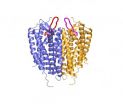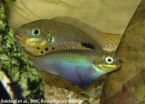(Press-News.org) Microbes matter -- perhaps more than anyone realizes -- in basic biological development and, maybe, they could be a target for reducing cancer risks, according to University of Oregon researchers.
In a study of very basic biology of zebrafish, scientists in the UO Institute of Molecular Biology focused on the developing intestine during its early formation in the sterile environment of its eggshell through the exposure to natural colonizing bacteria after hatching.
What they found was eye opening, said Karen Guillemin, professor of biology: Resident microbes in the still-maturing intestine send messages that promote non-disease-related cell proliferation in the same Wnt [pronounced went] signaling pathway where genetic mutations have long been known to give rise to colorectal cancer. The findings appeared online ahead of regular publication in the Proceedings of the National Academy of Sciences.
The complex Wnt pathway in the gut already is considered the starting point for more than 70 percent of sporadic colorectal cancers. In the study, researchers used normal zebrafish and those harboring mutations in the Wnt pathway. They were reared under germ-free conditions and then exposed under laboratory conditions to specific microbes to define how microbial signals interact with the Wnt pathway to promote cell proliferation in the gut.
"We were able to show that microbial signals do feed into and enhance signaling in the Wnt pathway. They feed in at a point after the node where most cancer-promoting genetic mutations occur," Guillemin said. "What this says is that for anyone who is at risk for developing cancer because they have these mutations, it matters what microbes these mutations are associated with. These two pieces of information contribute in parallel and feed into the same pathway."
The findings, she said, add fodder in an emerging shift in cancer research to look at the impact of microbes and other infectious causes of the disease. "It may be that associated microbes play as significant a role in cancer risk as genetic mutations," she said. "We need to learn more about the contributions of microbe signaling to cell proliferation. Maybe you could intervene with a targeted therapy. Even if you can't fix a mutation you might manipulate the associated microbes to change the interaction and reduce unwanted cell proliferation."
Genetic research on zebrafish – a high-priority model organism for the National Institutes of Health, which supported the project – began at the UO in the early 1970s. Guillemin, who recently received an early career investigator-scholar award from the NIH Institute of Digestive and Kidney Diseases, is known for her studies in zebrafish on the role of good bacteria in the gastrointestinal tract.
INFORMATION:
Co-authors on the paper were Sarah E. Cheesman, who was supported by an NIH Research Service Award fellowship, doctoral student James T. Neal and research technicians Erika Mittge and Barbara M. Seredick.
In addition to the NIH, the Burroughs Wellcome Fund supported the research.
About the University of Oregon
The University of Oregon is a world-class teaching and research institution and Oregon's flagship public university. The UO is a member of the Association of American Universities (AAU), an organization made up of the 63 leading public and private research institutions in the United States and Canada. The UO is one of only two AAU members in the Pacific Northwest.
Contact: Jim Barlow, director of science and research communications, 541-346-3481, jebarlow@uoregon.edu
Source: Karen Guillemin, associate professor of biology, 541-346-5999, kguillem@uoregon.edu
Links:
Guillemin web page: http://molbio.uoregon.edu/facres/guillemin.html
Institute of Molecular Biology: http://molbio.uoregon.edu/index.html
Gut microbes promote cell turnover by a well-known pathway
Biologists show good bacteria modulate an important signaling pathway where colorectal cancer takes root
2010-10-08
ELSE PRESS RELEASES FROM THIS DATE:
Scientists give extinct passenger pigeon a place on the family tree
2010-10-08
With bits of DNA extracted from century-old museum specimens, researchers have found a place for the extinct Passenger Pigeon (Ectopistes migratorius) in the family tree of pigeons and doves, identifying this unique bird's closest living avian relatives for the first time. The new analysis, which appears this month in Molecular Phylogenetics and Evolution, reveals that the Passenger Pigeon was most closely related to other North and South American pigeons, and not to the Mourning Dove, as was previously suspected.
"This research demonstrates the remarkable potential of ...
Doctors evaluating heart problems should consider checking fat deposits around the heart
2010-10-08
LOS ANGELES (Oct. 6, 2010) – Cardiac imaging researchers at Cedars-Sinai Heart Institute are recommending that physicians not overlook fatty deposits around the heart when evaluating patients for risk of major heart problems.
Although abdominal fat is often considered in making these assessments, recent research suggests that measuring fatty tissue around the heart is an even better predictor, and noninvasive CT scanning may provide this important information.
The recommendation appeared in an editorial comment published in the Journal of the American College of Cardiology: ...
Call to heal the world's coral reefs
2010-10-08
There is still time to save the world's ailing coral reefs, if prompt and decisive action can be taken to improve their overall health, leading marine researchers say.
Writing in the journal Trends in Ecology and Evolution, eminent marine scientists from Australia and the USA have called for an international effort to improve the resilience of coral reefs, so they can withstand the impacts of climate change and other human activities.
"The world's coral reefs are important economic, social and environmental assets, and they are in deep trouble. How much trouble, and ...
Disability and Health Journal critically examines Americans with Disabilities Act
2010-10-08
New York, NY, October 6, 2010 – In recognition of the 20th anniversary of the enactment of the Americans with Disabilities Act (ADA), the October issue of Disability and Health Journal has brought together a series of articles to examine whether the ADA has in fact improved the health of people with disabilities. Areas of progress are identified, most notably acknowledging physical barriers and need for better staff training and communication about and with people with disabilities. However, there continue to be ongoing challenges, including recurrent barriers to health ...
Missing self-injury behavior in youths with eating disorders, Stanford/Packard study finds
2010-10-08
STANFORD, Calif. - An alarming number of adolescents already battling eating disorders are also intentionally cutting themselves, and health-care providers may be failing to diagnose many instances of such self-injury, according to a new study from Stanford University School of Medicine and Lucile Packard Children's Hospital.
The researchers found that 40.8 percent of patients with eating disorders in their study had documented incidents of intentionally harming themselves, most often by cutting and burning. What's more, the study suggests that inadequate clinical screening ...
Genetically modified crop resistance to pests benefits non-modified crop, U of Minnesota study finds
2010-10-08
Transgenic corn's resistance to pests has benefitted even non-transgenic corn, a new study led by scientists from the University of Minnesota shows.
The study, published in the Oct. 8 edition of the journal Science, found that widespread planting of genetically modified Bt corn throughout the Upper Midwest has suppressed populations of the European corn borer, historically one of corn's primary pests. This areawide suppression has dramatically reduced the estimated $1 billion in annual losses caused by the European corn borer, even on non-genetically modified corn. Bt ...
Scientists reveal first structure of a class of proteins that help guide blood cell movement
2010-10-08
LA JOLLA, CA – October 4, 2010 – Researchers have determined the structure of a protein that helps guide blood-forming stem cells, or hematopoetic stem cells. The protein is also one of the main receptors used by the human immunodeficiency virus (HIV) to get inside blood cells.
The findings are described in the October 7, 2010 issue of the journal Science.
The structure offers a detailed view of how the cell surface receptor, called CXCR4, interacts with molecules outside the cell. The results have implications for developing new drugs for hematopoetic stem cell transplantation, ...
Study details structure of potential target for HIV and cancer drugs
2010-10-08
VIDEO:
This model shows how HIV, in gray, might latch on to immune cell receptor molecules, allowing the virus to enter and infect the cell. The viral protein, gp120, shown in...
Click here for more information.
In a technical tour de force, structural biologists funded by the National Institutes of Health have determined the three-dimensional structure of a molecule involved in HIV infection and in many forms of cancer. The high-resolution structure sheds light on how the ...
Study cites illegal means, threats to farmers in company's bid to control China's forests
2010-10-08
Washington, DC/Beijing, China (7-8 October 2010)—A new study released today in Washington, DC and Beijing suggests that one of the world's largest and "greenest" paper companies, in concert with local officials and other middlemen, used illegal means to gain control over thousands of hectares of Chinese forestlands, with a goal of acquiring 120 thousand hectares for a eucalyptus plantation in the Guangxi Autonomous Region of southern China.
The authors say their research shows that the middlemen, acting on behalf of Finnish paper and pulp manufacturer Stora Enso, often ...
Female fish flaunt fins to attract a mate
2010-10-08
For the first time, biologists have described the evolution of the size of a female trait which males use to choose a partner. The research, published in the open access journal BMC Evolutionary Biology, shows that male cichlid fish prefer females with a larger pelvic fin and that this drives females to grow fins out of proportion with their body size.
Sebastian Baldauf from the University of Bonn, Germany, worked with a team of researchers to study the effects of female ornamentation in the African cichlid fish Pelvicachromis taeniatus. He said, "In contrast to the ...
LAST 30 PRESS RELEASES:
The vast majority of US rivers lack any protections from human activities, new research finds
Ultrasound-responsive in situ antigen "nanocatchers" open a new paradigm for personalized tumor immunotherapy
Environmental “superbugs” in our rivers and soils: new one health review warns of growing antimicrobial resistance crisis
Triple threat in greenhouse farming: how heavy metals, microplastics, and antibiotic resistance genes unite to challenge sustainable food production
Earthworms turn manure into a powerful tool against antibiotic resistance
AI turns water into an early warning network for hidden biological pollutants
Hidden hotspots on “green” plastics: biodegradable and conventional plastics shape very different antibiotic resistance risks in river microbiomes
Engineered biochar enzyme system clears toxic phenolic acids and restores pepper seed germination in continuous cropping soils
Retail therapy fail? Online shopping linked to stress, says study
How well-meaning allies can increase stress for marginalized people
Commercially viable biomanufacturing: designer yeast turns sugar into lucrative chemical 3-HP
Control valve discovered in gut’s plumbing system
George Mason University leads phase 2 clinical trial for pill to help maintain weight loss after GLP-1s
Hop to it: research from Shedd Aquarium tracks conch movement to set new conservation guidance
Weight loss drugs and bariatric surgery improve the body’s fat ‘balance:’ study
The Age of Fishes began with mass death
TB harnesses part of immune defense system to cause infection
Important new source of oxidation in the atmosphere found
A tug-of-war explains a decades-old question about how bacteria swim
Strengthened immune defense against cancer
Engineering the development of the pancreas
The Journal of Nuclear Medicine ahead-of-print tip sheet: Jan. 9, 2026
Mount Sinai researchers help create largest immune cell atlas of bone marrow in multiple myeloma patients
Why it is so hard to get started on an unpleasant task: Scientists identify a “motivation brake”
Body composition changes after bariatric surgery or treatment with GLP-1 receptor agonists
Targeted regulation of abortion providers laws and pregnancies conceived through fertility treatment
Press registration is now open for the 2026 ACMG Annual Clinical Genetics Meeting
Understanding sex-based differences and the role of bone morphogenetic protein signaling in Alzheimer’s disease
Breakthrough in thin-film electrolytes pushes solid oxide fuel cells forward
Clues from the past reveal the West Antarctic Ice Sheet’s vulnerability to warming
[Press-News.org] Gut microbes promote cell turnover by a well-known pathwayBiologists show good bacteria modulate an important signaling pathway where colorectal cancer takes root


